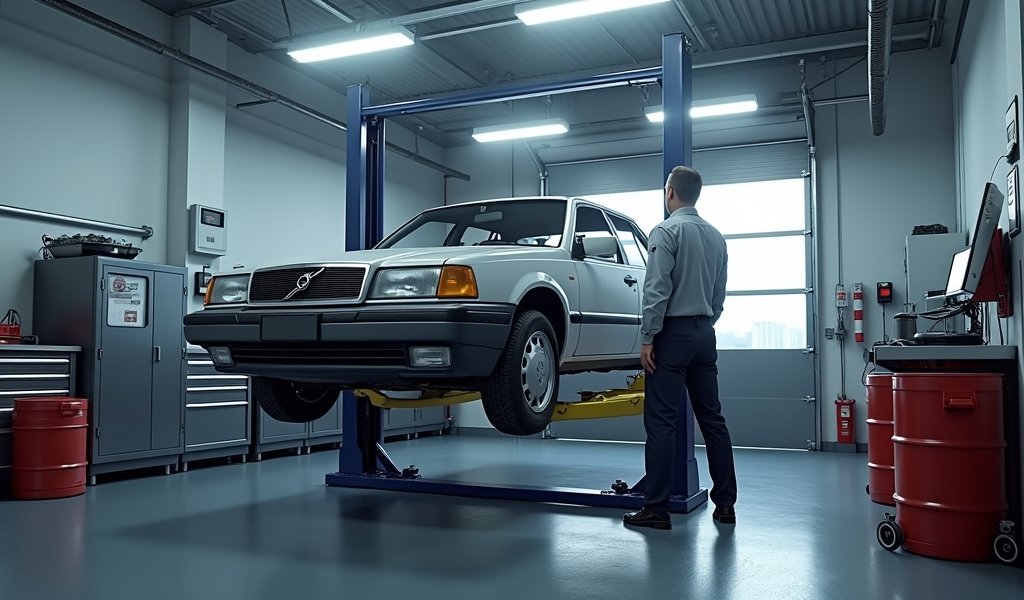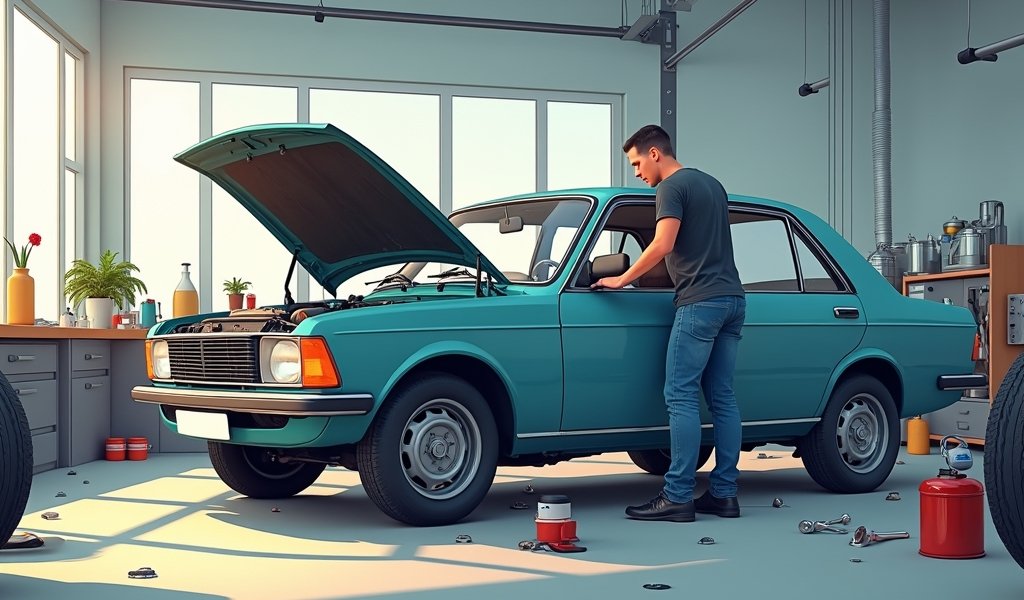Overview
This article details ten essential maintenance practices for used cars, including regular oil changes, filter replacements, tire care, battery maintenance, brake checks, fluid monitoring, timing component inspection, cooling system upkeep, suspension maintenance, and keeping detailed service records. Proper maintenance not only prevents costly repairs but also extends vehicle life, improves safety, and maintains resale value, with the author emphasizing that consistent care is always less expensive than major repairs.
Table of Contents
- Introduction to Used Car Maintenance
- 1. Regular Oil Changes
- 2. Filter Replacements
- 3. Tire Maintenance
- 4. Battery Care
- 5. Brake System Checks
- 6. Fluid Level Monitoring
- 7. Timing Belt/Chain Inspection
- 8. Cooling System Maintenance
- 9. Suspension and Steering Components
- 10. Keep a Maintenance Log
- Conclusion
- Frequently Asked Questions
Introduction to Used Car Maintenance
There’s something uniquely satisfying about giving a used car a second life. Whether you’ve just picked up a pre-owned vehicle or have been driving one for years, proper maintenance is the secret sauce that keeps it running smoothly for the long haul.
I’ve spent over two decades under the hood, and if there’s one thing I’ve learned, it’s that a well-maintained used car can outlast even newer models that suffer from neglect. Think of maintenance as preventive medicine – a little care now saves a mountain of trouble (and money) later.
This comprehensive car service checklist isn’t just about keeping your car running – it’s about peace of mind, safety, and protecting your investment. Let’s roll up our sleeves and dive into the 10 essentials every used car owner should know.
1. Regular Oil Changes: The Lifeblood of Your Engine
If engines could talk, they’d beg for fresh oil. It’s literally the lifeblood of your vehicle, and with used cars, it’s doubly important. Oil doesn’t just lubricate – it cleans, cools, and protects your engine from the inside out.
For older vehicles, I recommend erring on the conservative side with oil changes:
- Conventional oil: Every 3,000-5,000 miles
- Synthetic oil: Every 5,000-7,500 miles
Don’t get lulled into complacency by newer cars’ extended intervals. Used engines, with their microscopic wear patterns and aging seals, benefit tremendously from fresh oil. I’ve rebuilt enough engines to tell you that regular oil changes are the single best way to add years to your car’s life.
Check your dipstick monthly – oil should be amber to light brown, never black or gritty. And that little oil change sticker? It’s not just a suggestion – it’s your engine’s prescription for longevity.
2. Filter Replacements: Your Car’s Respiratory System

Think of your car’s filters like the masks we’ve all become accustomed to wearing – they prevent harmful particles from getting where they shouldn’t be. And just like a dirty mask, clogged filters can’t do their job effectively.
Your used car relies on several crucial filters:
- Air filter: Check every 15,000 miles or annually. When held up to light, you should see light passing through it.
- Fuel filter: Replace every 30,000-50,000 miles. This one’s often overlooked but can cause serious fuel system issues when neglected.
- Cabin air filter: Replace every 15,000-25,000 miles. Your lungs will thank you!
- Oil filter: Always replace with every oil change – no exceptions.
A clean air filter alone can improve acceleration performance by up to 11% in older vehicles, according to EPA studies. That’s like getting a free mini tune-up just by swapping a $15 part!
Pro tip: Write the installation date on the filter itself with a marker. It takes seconds but eliminates guesswork later.
3. Tire Maintenance: Where the Rubber Meets the Road
Your tires are literally where all your car’s engineering meets the road. With used cars, tire maintenance isn’t just about performance – it’s about safety.
Start with monthly pressure checks (including the spare). Proper inflation improves handling, extends tire life, and optimizes fuel economy. The correct pressure is usually listed on a sticker inside your driver’s door jamb – not the maximum PSI on the tire sidewall.
Rotation every 5,000-7,500 miles ensures even wear across all four corners. This simple step can extend your tire life by thousands of miles. While you’re at it, have your alignment checked annually – it’s worth every penny.
Don’t forget the penny test for tread depth: insert a penny with Lincoln’s head upside down into the tread. If you can see all of Honest Abe’s head, it’s time for new rubber.
With used cars, I also recommend checking the manufacture date on your tires (look for a four-digit code on the sidewall – “1019” means the 10th week of 2019). Even with good tread, tires over 6 years old have degraded rubber compounds and should be replaced for safety.
4. Battery Care: Power When You Need It
That moment when you turn the key and nothing happens? We’ve all been there, and it’s never convenient. Used car batteries need extra TLC, especially as they age.
Start with a visual inspection every few months. Look for corrosion on terminals (that white, powdery substance), secure connections, and proper mounting. A battery that moves around can suffer internal damage and fail prematurely.
Clean terminals with a solution of baking soda and water, then rinse thoroughly. A wire brush works wonders for stubborn corrosion. Finish with a thin coat of petroleum jelly or specialized terminal spray to prevent future buildup.
Most batteries last 3-5 years, but extreme temperatures accelerate aging. If your battery is approaching the 3-year mark, consider having it tested professionally during your next service. Many auto parts stores offer this service for free.
For vehicles driven infrequently, consider a trickle charger or battery maintainer to prevent the gradual discharge that shortens battery life. It’s a small investment that pays dividends in reliability.
5. Brake System Checks: Safety First

When it comes to brakes on used cars, never settle for “good enough.” These critical safety components deserve your attention before they demand it with scary noises or pulling.
Learn to recognize the early warning signs of brake wear:
- Squealing or grinding noises when braking
- Pulsation or vibration through the brake pedal
- Vehicle pulling to one side during braking
- Increased stopping distance
- Brake pedal feels “soft” or sinks to the floor
Have your brake pads inspected with every oil change or tire rotation. Most shops will do a quick visual check for free, and catching wear early prevents damage to more expensive components like rotors.
Don’t forget about brake fluid! This hygroscopic fluid absorbs moisture over time, lowering its boiling point and compromising braking performance. I recommend flushing the system every 2-3 years, regardless of mileage.
Pro tip: After driving through deep water, tap your brakes lightly several times to dry them out. This simple habit prevents surprise braking issues and extends rotor life.
6. Fluid Level Monitoring: Your Car’s Vital Systems
Think of your car’s fluids like the bloodstream of a living organism – they transfer power, dissipate heat, and keep critical systems functioning. With used vehicles, fluid leaks become increasingly common, making regular checks essential.
Create a monthly fluid check routine that includes:
- Engine oil: Check when cold for accurate reading
- Transmission fluid: Usually checked with engine running (consult your owner’s manual)
- Power steering fluid: Look for appropriate level and clear, reddish color
- Brake fluid: Should be between “MIN” and “MAX” lines on the reservoir
- Coolant/antifreeze: Check when engine is cool to avoid burns
- Windshield washer fluid: Top off regularly, especially in winter months
Beyond just levels, pay attention to fluid condition. Discoloration, particles, or unusual smells often signal internal problems. For instance, milky oil can indicate a head gasket leak, while dark, burnt-smelling transmission fluid suggests overheating.
When topping off fluids, always use the manufacturer’s recommended type. Using the wrong fluid can cause serious damage – especially with transmission and brake systems. When in doubt, consult your routine vehicle maintenance schedule in your owner’s manual.
7. Timing Belt/Chain Inspection: Prevent Catastrophic Engine Damage
Here’s a maintenance item that separates the car care savvy from the novices. Your engine’s timing components synchronize the precise dance between pistons and valves. When they fail, the results can be catastrophically expensive.
First, determine whether your vehicle has a timing belt or chain. Generally, timing belts require replacement every 60,000-100,000 miles, while timing chains often last the lifetime of the engine (though they’re not immortal).
If your used car has a timing belt and you don’t know when it was last replaced, don’t gamble – replace it immediately. The $500-800 replacement cost pales in comparison to the $2,000-5,000 engine rebuild that might be necessary if it fails.
Signs of potential timing component issues include:
- Engine misfiring or rough running
- Ticking noise from the engine
- Oil leaks from the timing cover
- Check engine light with specific timing-related codes
When replacing the timing belt, smart owners also replace the water pump, tensioners, and pulleys simultaneously. Since the labor is largely the same, it’s economical to refresh the entire system while everything is accessible.
8. Cooling System Maintenance: Prevent Overheating
I’ve seen more engines destroyed by cooling system neglect than almost any other maintenance oversight. Your used car’s cooling system faces constant pressure, temperature extremes, and the gradual breakdown of its components.
Start with a visual inspection of all hoses and connections. Look for bulges, cracks, or leaks, paying special attention to where hoses connect to the radiator, engine, and heater core. Squeeze them when cool – they should feel firm but flexible, never brittle or excessively soft.
Check your radiator cap for proper sealing and pressure rating. This humble component regulates the entire cooling system’s pressure, and a bad one can cause overheating even when everything else is perfect.
Flush and replace coolant according to your manufacturer’s schedule – typically every 2-5 years or 30,000-60,000 miles. Use the specified type of coolant; mixing types can cause corrosion and component failure.
Lastly, ensure your electric cooling fans are operating properly. On most modern vehicles, they should activate when the A/C is turned on or when the engine reaches operating temperature. A simple check that can prevent a complex problem.
9. Suspension and Steering Components: Comfort and Control
A used car’s suspension and steering components quietly deteriorate over time, often so gradually that you might not notice until significant wear has occurred. These systems affect not just comfort but handling, braking distance, and overall safety.
Listen for telltale clunks, knocks, or rattles when driving over bumps or making turns. Pay attention to how your car handles – excessive bouncing, nose-diving during braking, or a tendency to “wander” on straight roads all indicate wear.
Have a professional inspect these components annually:
- Shocks/struts: Look for leaking fluid or worn bushings
- Ball joints: Critical safety components that can cause steering loss if they fail
- Tie rod ends: Connect your steering rack to your wheels
- Control arm bushings: Isolate vibration while maintaining proper wheel alignment
- Sway bar links: Help reduce body roll during cornering
When replacing suspension components, I always recommend working in pairs (both front shocks, both rear struts, etc.) to maintain balanced handling. While it’s tempting to replace only the worn side, this approach often leads to uneven wear and handling issues.
For vehicles with over 100,000 miles, consider a complete suspension refresh. The improvement in handling, comfort, and safety can make an older car feel new again.
10. Keep a Maintenance Log: Document Your Diligence
In my decades working as a mechanic, I’ve seen countless vehicles traded in or sold far below their value because owners couldn’t prove their maintenance history. A detailed maintenance log is like a resume for your car – it tells the next owner how well you’ve cared for it.
Start a simple notebook or digital file to record:
- Date and mileage of each service
- Detailed description of work performed
- Parts replaced and their specifications
- Name of the shop or mechanic who performed the work
- Cost of services (useful for budgeting future maintenance)
Save all receipts and service records in a dedicated folder. For major repairs, take before-and-after photos as additional documentation. Many popular apps can help you track maintenance, set reminders, and even estimate future service needs based on your driving patterns.
A comprehensive maintenance log doesn’t just help with resale value – it helps you spot patterns and potential issues before they become serious problems. Noticing you’re topping off coolant more frequently? That minor observation recorded in your log could help catch a developing leak before it leaves you stranded.
This simple habit can add hundreds or even thousands to your car’s resale value while providing a roadmap for future maintenance needs. It’s one of the best car maintenance practices that costs nothing but offers substantial returns.
Conclusion: The Reward of Diligent Maintenance
Taking care of a used car isn’t just about avoiding breakdowns – it’s about transforming a depreciating asset into a reliable companion that serves you faithfully for years. Every oil change, filter replacement, and tire rotation is an investment in your vehicle’s longevity and your financial well-being.
The beauty of proper maintenance is that it’s almost always cheaper than repair. That $40 oil change prevents a $4,000 engine rebuild. That $20 air filter helps avoid $200 in wasted fuel. It’s simple mathematics that pays dividends with every mile.
Remember that no one knows your car better than you do. Pay attention to new noises, vibrations, or performance changes. Trust your instincts – if something feels different, it probably is.
At Knows Your Car, we understand that not everyone has a mechanic’s knowledge or access to specialty tools. That’s why we’ve developed proprietary diagnostic technology that you can use yourself to identify potential issues before they become major problems. Our team can help estimate repair costs from various mechanics and connect you with professionals who best meet your specific needs.
Have questions about maintaining your specific vehicle? Reach out to us at Contact@Knowsyourcar.com or call 1-888-588-2361. Your used car has plenty of life left in it – with the right care, it might just be the most economical and reliable vehicle you’ve ever owned.
Frequently Asked Questions
How often should I change the oil in my used car?
For most used cars, change conventional oil every 3,000-5,000 miles and synthetic oil every 5,000-7,500 miles. Older engines benefit from more frequent oil changes than what might be recommended for newer vehicles.
What’s the most important maintenance item for a used car?
Regular oil changes are the single most important maintenance item for extending engine life. Clean oil properly lubricates engine components and removes harmful contaminants that can cause premature wear.
How do I know if my used car needs new tires?
Use the penny test by inserting a penny with Lincoln’s head upside down into the tread groove – if you can see all of Lincoln’s head, it’s time for new tires. Also check for sidewall cracks, bulges, and uneven wear patterns.
Should I replace my timing belt even if it looks fine?
Yes, always replace timing belts according to the manufacturer’s mileage recommendation, even if they appear to be in good condition. Internal deterioration isn’t always visible, and timing belt failure can cause catastrophic engine damage.
How can I extend my used car’s battery life?
Keep terminals clean and connections tight, avoid leaving electronics on when the engine isn’t running, and consider a battery maintainer for vehicles driven infrequently. Have the battery tested annually after it reaches three years of age.

